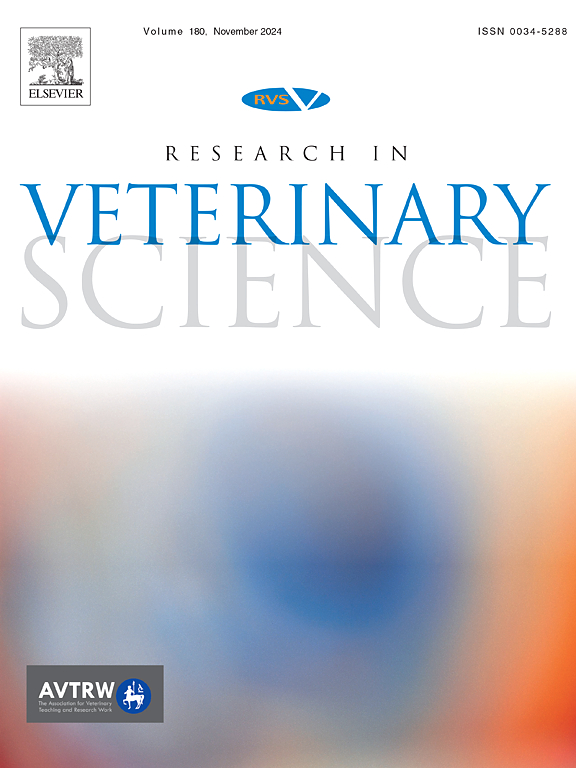Gastric habronematidosis in mules: Gastroscopy and histopathology-based diagnosis
IF 2.2
3区 农林科学
Q1 VETERINARY SCIENCES
引用次数: 0
Abstract
This cross-sectional study aimed to describe the presence of gastric habronematidosis using gastroscopy and histopathology as diagnostic methods, in addition to evaluating the relationship between the parasite presence and concurrent gastric diseases. Numerous studies have been carried out with equines, mules not being targeted even though these are representative species because of number and the various agricultural tasks they perform worldwide. To fill this gap in the literature, this study evaluated a population of 97 male and female mules over two years old using two diagnostic methods. Samples were taken from the gastric mucosa of mules presenting lesions compatible with Squamous Gastric Disease (SGD) or Glandular Gastric Disease (GGD). The Spearman's test was used to determine the correlation coefficients between the outcomes and explanatory variables of the study, i.e., parasites with gastritis/equine gastric ulcer syndrome (EGUS)/GGD/SGD/age/sex/body condition score (BCS). Gastroscopy evidenced the presence of nematodes morphologically compatible with Habronema spp. in 11.3 % of the individuals, and histopathology showed that 5.6 % of the mules had inflammatory processes associated with chronic eosinophilic gastritis with intralesional parasites. No correlation (p > 0,05) was found between the presence of parasites and the variables studied. These results confirm the presence of gastric habronematidosis in mules, which has not been reported for this species.
骡子胃纤维线虫病:胃镜检查和组织病理学诊断。
本横断面研究旨在通过胃镜检查和组织病理学作为诊断方法来描述胃线虫病的存在,并评估寄生虫存在与并发胃疾病之间的关系。尽管马和骡子是具有代表性的物种,但由于它们的数量和在世界范围内从事的各种农业任务,许多研究都没有将它们作为目标。为了填补这一文献空白,本研究使用两种诊断方法评估了97只两岁以上的雄性和雌性骡子。从呈现与鳞状胃病(SGD)或腺状胃病(GGD)相容病变的骡子胃黏膜中采集样本。采用Spearman检验确定研究结果与解释变量(寄生虫伴胃炎/马胃溃疡综合征(EGUS)/GGD/SGD/年龄/性别/体况评分(BCS))之间的相关系数。胃镜检查证实11.3%的个体中存在与Habronema属形态相容的线虫,组织病理学显示5.6%的骡子有与慢性嗜酸性胃炎相关的炎症过程,伴有病灶内寄生虫。寄生虫的存在与所研究的变量之间没有相关性(p >0,05)。这些结果证实了在骡子中存在胃纤维线虫病,这在该物种中尚未报道。
本文章由计算机程序翻译,如有差异,请以英文原文为准。
求助全文
约1分钟内获得全文
求助全文
来源期刊

Research in veterinary science
农林科学-兽医学
CiteScore
4.40
自引率
4.20%
发文量
312
审稿时长
75 days
期刊介绍:
Research in Veterinary Science is an International multi-disciplinary journal publishing original articles, reviews and short communications of a high scientific and ethical standard in all aspects of veterinary and biomedical research.
The primary aim of the journal is to inform veterinary and biomedical scientists of significant advances in veterinary and related research through prompt publication and dissemination. Secondly, the journal aims to provide a general multi-disciplinary forum for discussion and debate of news and issues concerning veterinary science. Thirdly, to promote the dissemination of knowledge to a broader range of professions, globally.
High quality papers on all species of animals are considered, particularly those considered to be of high scientific importance and originality, and with interdisciplinary interest. The journal encourages papers providing results that have clear implications for understanding disease pathogenesis and for the development of control measures or treatments, as well as those dealing with a comparative biomedical approach, which represents a substantial improvement to animal and human health.
Studies without a robust scientific hypothesis or that are preliminary, or of weak originality, as well as negative results, are not appropriate for the journal. Furthermore, observational approaches, case studies or field reports lacking an advancement in general knowledge do not fall within the scope of the journal.
 求助内容:
求助内容: 应助结果提醒方式:
应助结果提醒方式:


